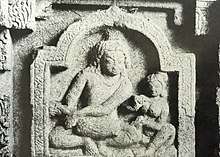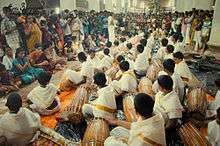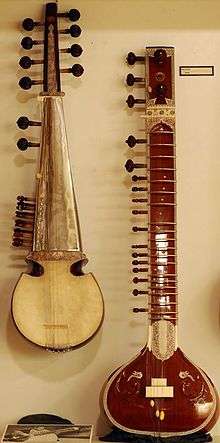Mridangam
The mridangam is a percussion instrument of ancient origin. It is the primary rhythmic accompaniment in a Carnatic music ensemble, and in Dhrupad, where the same instrument is referred to as pakhawaj.
 | |
| Percussion instrument | |
|---|---|
| Related instruments | |
| Musicians | |
| |
| More articles or information | |
| Carnatic music |
During a percussion ensemble, the mridangam is often accompanied by the ghatam, kanjira, and morsing.
Etymology
The word "Mridangam" is Sandhi or union of the two Sanskrit words mŗt (clay or earth) and anga (limb), as early Mridangam were made of hardened clay.
Legend
In ancient Hindu sculpture, painting, and mythology, the mridangam is often depicted as the instrument of choice for a number of deities including Ganesha (the remover of obstacles) and Nandi, who is the vehicle and follower of Shiva. Nandi is said to have played the mridangam during Shiva's primordial tandava dance, causing a divine rhythm to resound across the heavens. The mridangam is thus also known as "deva vaadyam," or "Divine Instrument".
History
Over the years, the mridangam evolved to be made of different kinds of wood due to its increased durability, and today, its body is constructed from wood of the jackfruit tree. It is widely believed that the tabla, the mridangam's Hindustani musical counterpart, was first constructed by splitting a mridangam in half. With the development of the mridangam came the tala (rhythm) system.
Mridangam has a large role in Newa music. One of the earliest Nepal Bhasa manuscripts on music is a treatise on this instrument called Mridanga anukaranam.[1] The importance of a beating has changed over the years. In the old days, percussionists only used to accompany the lead player like the vocalist but this time their development is not restricted to accompaniment only but also to play one instrument shows.
Tamil culture
In Tamil culture, it is called a tannumai.[2] The earliest mention of the mridangam in Tamil literature is found perhaps in the Sangam literature where the instrument is known as 'tannumai'. In later works like the Silappadikaram also we find detailed references to it as in the Natyasastra.[3] During the Sangam period, it was one of the principal percussion instruments to sound the beginning of war along with murasu , tudi and parai because it was believed that its holy sound will deflect enemy arrows and protect the King.[4] During the post-Sangam period, as mentioned in the epic Silappadikaram , it formed a part of the antarakoṭṭu [5][6] - a musical ensemble at the beginning of dramatic performances that would later develop into Bharathanatyam.[7] The player of this instrument held the title tannumai aruntozhil mutalvan .[8]
Construction
The mridangam is a double-sided drum whose body is usually made using a hollowed piece of jackfruit wood about an inch thick. The two mouths or apertures of the drum are covered with a goatskin and laced to each other with leather straps around the circumference of the drum. These straps are put into a state of high tension to stretch out the circular membranes on either side of the hull, allowing them to resonate when struck. These two membranes are dissimilar in width to allow for the production of both bass and treble sounds from the same drum.
The bass aperture is known as the thoppi or eda bhaaga and the smaller aperture is known as the valanthalai or bala bhaaga. The smaller membrane, when struck, produces higher pitched sounds with a metallic timbre. The wider aperture produces lower pitched sounds. The goat skin covering the smaller aperture is anointed in the center with a black disk made of rice flour, ferric oxide powder and starch. This black tuning paste is known as the satham or karanai and gives the mridangam its distinct metallic timbre.
The combination of two inhomogeneous circular membranes allows for the production of unique and distinct harmonics. Pioneering work on the mathematics of these harmonics was done by Nobel Prize–winning physicist C. V. Raman.[9][10]
Methods of use
Immediately prior to use in a performance, the leather covering the wider aperture is made moist and a spot of paste made from semolina (rawa) and water is applied to the center, which lowers the pitch of the left membrane and gives it a very powerful resonating bass sound. Nowadays, rubber gum is also used to loosen the membrane helping in creating the bass sound, and its advantage is that unlike semolina, it will not stick on hands. The artist tunes the instrument by varying the tension in the leather straps spanning the hull of the instrument. This is achieved by placing the mridangam upright with its larger side facing down, and then striking the tension-bearing straps located along of circumference of the right membrane with a heavy object (such as a stone). A wooden peg is sometimes placed between the stone and the mridangam during the tuning procedure to ensure that the force is exerted at precisely the point where it is needed. Striking the periphery of the right membrane in the direction toward the hull raises the pitch, while striking the periphery from the opposite side (away from the hull) lowers the pitch. The pitch must be uniform and balanced at all points along the circumference of the valanthalai for the sound to resonate perfectly. The pitch can be balanced with the aid of a pitch pipe or a tambura. The larger membrane can also be tuned in a similar manner, though it is not done as frequently. Note that since the leather straps are interwoven between both the smaller and larger aperture, adjusting the tension on one side often can affect the tension on the other.
Posture

The mridangam is played resting it almost parallel to the floor. A right-handed mridangam artist plays the smaller membrane with their right hand and the larger membrane with the left hand.
The mridangam rests above the right ankle (but not on it), the right leg being slightly extended, while the left leg is bent and rests against the hull of the drum and against the torso of the artist. It is extremely important that the two sides of the hips are level, to prevent a habitual lateral pelvic tilt. For a left-handed percussionist, the legs and hands are switched.
There have recently been reports of altered gait and in balance in those that play the mridangam for extended periods of time (more than several hours a day). This is likely due to the different coordination requirements between the two sides of the upper body within the muscles of the abdomen, thorax, back and upper limbs. Issues may also be caused by the asymmetrical leg positions at the hip encouraging a lateral pelvic tilt. Musicians should also watch out for the torso leaning over to the dominant side to view the head of the drum more easily, which unfortunately causes uneven shoulders. It is recommended that the musician sits completely straight, with hips, spine and shoulders completely even. Wooden stands may help alleviate issues with scoliosis.
This can result in difficulty in walking and running efficiently therefore may affect the artists' ability to play sport in the future. It is not known whether all round strength training, or playing the drum with the contralateral side of the body may prevent or alleviate these problems. Therefore, it is strongly advised to notify minors and their parents of issues associated with the drum.
When played without care to posture, the miruthangam has the potential to have life long effects to one's posture, including even hips, shoulders and scoliosis.
Regular stretching, weight training and sports is also crucial for those that play regularly.
Physiotherapists are likely to struggle to treat issues because they are unfamiliar with the unusual nature of the drum. Research on the miruthangam and postural issues are yet to be done.
Strokes
Basic strokes on the mridangam:
- Tha: Non-vibrating tone played on the left-hand side with the whole palm / Non-vibrating tone played on the right-hand side with 3 fingers.
- Dhi: Non-vibrating tone played on the center black portion of the right-hand side using middle, ring, and small fingers.
- Thom: Vibrating tone played on the outer side of the left-hand side.
- Nam: Vibrating tone played on the outer layer of the right-hand side using the index finger, minimizing the black portion vibration with middle or ring finger- place the third finger in the gap in-ring and the second finger hits the outer layer of the right-hand side of the Mrudangam (called 'Saatham').
There is also a parallel set of rhythmic solfa passages (known as "solkattu") which is sounded by mouth to mimic the sounds of the mridangam. Students of this art are required to learn and vigorously practice both the fingering strokes and solfa passages to achieve proficiency and accuracy in this art.
Advanced strokes:
Many other strokes are also taught as the training becomes more advanced, which are generally used as aesthetic embellishments while playing. These notes include gumki (or gamakam), and chaapu. The combination of these finger strokes produces complex mathematical patterns that have both aesthetic and theoretical appeal. Increasingly complex calculations (kanakku) and metres (nadais) may be employed when the mridangam is played.
- Ta: A sharp flat note played with the index finger in the middle of the black portion on the right side of the mridangam.
- Gumukki: A variating bass tone produced by playing on the inner layer of the lower end of the left-hand side. Sound is produced only when there is a special applied paste.
- Full Chapu: It is a vibrating tone played with the small finger on the right-hand side, between the black patch and the outer layer. The sound is tuned to the tonic of the tambura.
- Ara Chapu: A note similar to Chapu, but is an octave higher, and is played with the side of the hand and less of the pinky.
- Dheem: A vibrational tone version of nam played on the black portion of the mridangam.
Classically, training is by dharmic apprenticeship and includes both the yoga of drum construction and an emphasis on the internal discipline of voicing mridangam tone and rhythm both syllabically and linguistically, in accordance with Rigveda, more than on mere performance.
Types of Talam, each with specific angas and aksharas:
- dhruva thaalam
- matyatalam
- roopaka talam
- jhampe talam
- Ata talam
- ek talam
- triputa talam
Modern usage
Today the mridangam is most widely used in Carnatic music performances. These performances take place all over Southern India and are now popular all over the world. As the principal rhythmic accompaniment (pakkavadyam), the mridangam has a place of utmost importance, ensuring all of the other artists are keeping their timing in check while providing support to the main artist. One of the highlights of a modern Carnatic music concert is the percussion solo (thani avarthanam), where the mridangam artist and other percussionists such as kanjira, morsing, and ghatam vidwans exchange various complex rhythmic patterns, culminating in a grand finale where the main artists resumes where he or she left off.
Mridangam is used as an accompanying instrument in Yakshagana Himmela (orchestra) where it is called the maddale. However, the mridangam used in Yakshagana is markedly different in structure and acoustics from the ones used in Carnatic music.
Significant players of the mridangam in modern times are T. K. Murthy, T. V. Gopalakrishnan, Umayalpuram K. Sivaraman, Vellore G. Ramabhadran, T S Nandakumar, Karaikudi Mani, Trichy Sankaran, Mannargudi Easwaran, Yella Venkateswara Rao,[11] and Thiruvarur Bakthavathsalam, who have been playing and advancing the technique for decades.
Mridangamela

Mridangamela is a synchronized performance of mridangam by a group of artists. The concept of Mridangamela was developed by Korambu Subrahmanian Namboodiri and is currently propagated by Korambu Vikraman Namboodiri.[12] Mridangamela is designed to be easily performed and managed even when performed by a group of children. It is common that the age of artists can range from 3 years to above. Most Mridangamelas are performed by children soon after their initiation to learning mridangam. Teaching method developed to train for Mridangamela made this easy to be taught and contributed to its popularity.[13] In Koodalmanikyam Temple, Irinjalakuda, it is a tradition that Mridangamela is held by children of the age group 3 years and above, as soon as the Utsavam is flagged off.[14] This is performed as an offering to Lord Bharata, who is the deity of Koodalmanikyam Temple.[15] In 2014, Mridangamela by 75 children was performed at Chembai Sangeetholsavam, which is the annual Carnatic music festival held in Guruvayur by the Guruvayur Devaswom. Mridangamela had been performed at Chembai Sangeetholsavam for the past 35 years orchestrated by Korambu Mridanga Kalari.[16]
Players
Over the years and especially during the early 20th century, great maestros of mridangam also arose, inevitably defining "schools" of mridangam with distinct playing styles. Examples include the Puddukottai school and the Thanjavur school. The virtuosos Palani Subramaniam Pillai, Palghat Mani Iyer and C.S. Murugabhupathy contributed so much to the art that they are often referred to as the Mridangam Trinity.
Past players
- Pudukkottai Dakshinamurthy Pillai
- Palghat Mani Iyer
- Palani Subramaniam Pillai
- Ramanathapuram C. S. Murugabhoopathy
- Palghat R. Raghu
- Mavelikkara Velukkutty Nair
- Mavelikara Krishnankutty Nair
Current players
- Umayalpuram K Sivaraman
- T. V. Gopalakrishnan
- T. K. Murthy
- Yella Venkateswara Rao
- Trichy Sankaran
- Guruvayur Dorai
- Karaikudi Mani
- T S Nandakumar
- Mannargudi Easwaran
- Thiruvarur Bakthavathsalam
- Anoor Anantha Krishna Sharma
- Srimushnam V. Raja Rao
- Patri Satish Kumar
- Trichur C. Narendran
- A. V. Anand
- Tiruvarur Vaidyanathan
- Erickavu N. Sunil
References
- Book: Nepalbhasa sahitya ya itihaas, Author: Prof. Premshanti Tuladhar, Publication: Nepalbhasa Academy, ISBN 978-99933-56-00-4
- Cuntaram, Pi. Em., Kalākēndra, T. (2010). Great layavadyakaaraas of Karnatak music. Percussive Art Centre.CS1 maint: multiple names: authors list (link)
- Kalakshetra vol 8. p. 49.
- Surabhi: Sreekrishna Sarma felicitation. Prof. E.R. Sreekrishna Sarma Felicitation Committee. 1983. p. 90.
- T.S. Parthasarathy. "BHARATANATYAM IN HISTORY". Carnatica.net. Retrieved 26 February 2013.
- Iḷaṅkōvaṭikaḷ, Daniélou A. (1965). Shilappadikaram: (The Ankle Bracelet). New Directions Publishing. p. 14. ISBN 0811200019.
- Viswanathan, Lakshmi (1984). Bharatanatyam, the Tamil heritage. Sri Kala Chakra Trust. p. 23.
- Tamil Studies, Volume 3. International Institute of Tamil Historical Studies. 1983. p. 36.
- Raman and Kumar 1920, Musical drums with harmonic overtones. Nature (London) 104 500, 453-454
- Raman 1935, The Indian musical drums. Proc. Indian Acad. Sci. A1 179-188
- Padma Shri Awards (2000–09)
- ""Mridangam concert at Christ Nagar School", IBNLive.com". Archived from the original on 4 March 2016. Retrieved 4 August 2015.CS1 maint: BOT: original-url status unknown (link).
- (2009). "Spectacular Mridangamela", NewIndianExpress.com.
- (2015). "Irinjalakuda", Mathrubhumi.com (in Malayalam).
- (2015). ""Irinjalakuda", Mathrubhumi.com". Archived from the original on 4 March 2016. Retrieved 9 December 2018.CS1 maint: BOT: original-url status unknown (link) (in Malayalam).
- "Archived copy". Archived from the original on 23 September 2015. Retrieved 4 August 2015.CS1 maint: archived copy as title (link)
